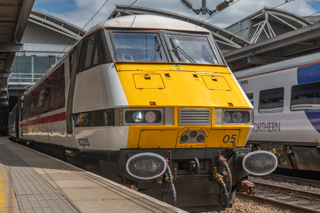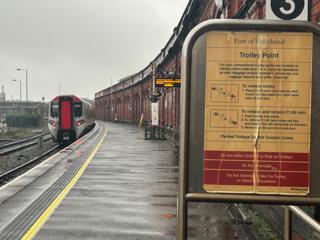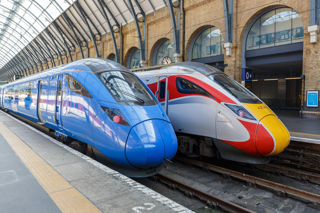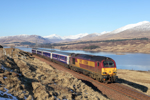The network isn’t as bad as some politicians suggest, says Philip Haigh, but relatively small tweaks to infrastructure such as chord reinstatements and longer platforms can still lead to positive changes for passengers.
Lancashire beat Yorkshire by a few days in rolling out major rail plans.
The network isn’t as bad as some politicians suggest, says Philip Haigh, but relatively small tweaks to infrastructure such as chord reinstatements and longer platforms can still lead to positive changes for passengers.
Lancashire beat Yorkshire by a few days in rolling out major rail plans.
For the west side of the Pennines, it was the Liverpool-Manchester Railway proposal for a new line (see Analysis, pages 22-23). For the drier side, it was Lord Blunkett’s report into improving Yorkshire’s rail network.
Top of Yorkshire’s list is new trains - and enough of them to deliver reliable services.
That’s a fair ask when you consider that much of Northern’s fleet (which operates across both regions) is approaching or has passed its 40th birthday.
Take Neville Hill Depot’s 150001, built in York in 1985, with the rest of this class of Sprinter diesel multiple units (DMUs) following over the next year.
Or the slightly superior Class 156s, built by Metropolitan-Cammell in 1987-89.
Together with the now withdrawn Pacer railbuses, they replaced British Rail’s first-generation DMUs, which were widely regarded as long past their best despite being only 30 years old at the time.
Even Northern’s newest former BR DMU, the Class 158s, rolled off production lines between 1989 and 1992.
So, there should be a good case for replacing all these second-generation DMUs over the next few years. But consider that TransPennine Express introduced three new fleets across its network over the past five years, but has since discarded one of the two new fleets that served Yorkshire. Now it says it needs new trains.
Overall, new trains should be the easy bit of the plan. Yet the question of what replaces diesel trains is far from settled.
And nor is it just Northern. Several train operators have similar stock of similar age (East Midlands, Great Western and South Western, for example), so this is something to which Great British Railways should direct its mind.
Then there’s infrastructure. Inevitably, this latest plan comes with a shopping list of new stations. Haxby, Elland, Thorpe Park, Rotherham Gateway, Dearne Valley Parkway and Leeds Bradford Airport Parkway all feature, as does the stalled construction of White Rose station in Leeds.
There’s electrification, too, which has to be linked into future rolling stock plans. Extending wires onwards from Sheffield to Leeds seems obvious, assuming Midland Main Line electrification reaches Sheffield in the first place.
Wiring the Calder Valley also makes sense, including Leeds-Bradford Interchange. But does the case diminish west of Todmorden once services towards Manchester and Preston/Blackpool have gone their separate ways?
While these ideas point towards a better railway, I can’t agree with West Yorkshire Mayor Tracey Brabin’s contention that “a lack of investment stretching back decades has left Yorkshire with a rail network no longer fit for purpose”.
Yorkshire has a good network, thanks in large part to the work of the South and West Yorkshire Passenger Transport Executives in the 1980s and 1990s. They reopened stations, supported services, and drove forward projects such as Leeds North West electrification that took wires out to Skipton, Ilkley and Bradford Forster Square.
And it was at Forster Square on May 19 that LNER introduced its improved London service for Bradford, with an increase to seven daily services on a weekday. These trains cover the 13.5 miles from Leeds in 21 minutes.
To look at Blunkett’s report, you’d think these were the only trains linking the two cities. The report’s Figure 7 shows the services between Yorkshire’s major cities, but you have to read the accompanying notes to realise that the graphic shows only fast LNER, TPE and CrossCountry services and excludes open access and Northern.
Yet Northern’s Leeds-Bradford Interchange services take between 18 and 22 minutes. With four per hour, three-quarters of them are quicker than LNER’s fast service, heading west to Manchester Victoria, Halifax, Chester or Blackpool North on a cycle of Leeds departures at xx12, xx26, xx43 and xx57.
Then there are Northern trains running every half-hour from Leeds to Forster Square, taking 25 minutes and stopping at four stations along the way - including Kirkstall Forge and Apperley Bridge, which are both recent additions to the network. Pesky things are stations if you’re interested in only fast services.
Which is not to criticise LNER’s improvements, facilitated by a fourth platform being recently built at Forster Square. But I will criticise a report that at first glance suggests the two cities have a poor service, when the reality is six trains per hour plus LNER’s seven (Grand Central’s four Londons per day avoid Leeds).
But here’s a suggestion that could further improve Bradford’s links: reinstate Wortley West Chord, which British Rail closed in 1985.
Network Rail bought the 770-yard trackbed last year. Returning its tracks would allow LNER to link London and Bradford Interchange without a time-consuming 18-minute reversal in Leeds station.
And as we’ve seen that Northern covers Leeds-Bradford Interchange in 18 minutes, then I reckon a future LNER service from London could be in Bradford before today’s have even left Leeds.
So, if there’s ever space on the East Coast Main Line (a very big ask!) for a third hourly West Yorkshire service, then how about sending it straight to Bradford?
More widely, rail services in West and South Yorkshire remain at the mercy of the counties’ geography. Hills and valleys make curves and gradients a fact of life.
It means that Leeds-Sheffield via Barnsley is slow as the train swings back and forward across the map. Meanwhile, the faster route sits in CrossCountry’s hands, with its crowded trains trying to serve a long-distance market with a regional stopping pattern.
Some relief should come in December, when Northern expects to start running a Leeds-Sheffield fast service via Wakefield Westgate.
Sheffield-Bradford has no direct trains of any speed. Passengers must change at Leeds. The chance of direct trains ended when British Rail closed its 1.5-mile Crigglestone Chord in 1991. Even with that in place, trains would have to take a circuitous route via Halifax because the more direct line via Liversedge Central closed in 1980.
Whether either cities’ stations have space for another couple of trains each hour to link the two, even with Crigglestone in place, remains another matter.
The same goes for York, which the report also complains has poor links. Perhaps Northern could increase its trains that take the direct route via Pontefract and Rotherham (avoiding both Leeds and Doncaster), but again there’s the matter of station capacity at each end.
Might those two redundant platforms that face south at York see tracks, trains and passengers once again?
Perhaps it’s to Blunkett’s credit that his report raises the problem, but resists the temptation to crayon maps with the answers.
But then he talks about Northern Powerhouse Rail. This is the pipedream of a new railway across the Pennines, complete with a 126-hectare Southern Gateway in Bradford which the report describes as a “King’s Cross of the North”.
NPR remains a distraction, over-promoted as the key to Bradford’s poor rail service, which we’ve seen is anything but poor. There’s a hint of this in the report, which even admits: “NPR remains a name without a clear policy and pathway for delivery.”
At least this report promotes and supports Network Rail’s £10 billion Transpennine Route Upgrade (TRU) which plans to electrify Leeds-Huddersfield-Manchester. It’s currently concentrating heavily on upgrading junctions and tracks around Huddersfield.
Perhaps it’s time to ditch NPR and concentrate on Yorkshire’s geographic problem of having several large cities, as well as a second tier of sizeable towns, that all need decent, frequent services.
There are plenty of smaller-scale improvements to be made, such as longer platforms (as Blunkett’s report suggests), that allow longer trains to run.
At Leeds, for example, making Platform 17 longer may help. The report claims its length prevents anything longer than a two-car train running. The platform is 106 metres long, so could take longer trains, but in practice it often accommodates a pair of two-car units which have come from or are going to different destinations.
Then there’s Northern’s performance, as we approach the first anniversary of it being served a breach notice for excess cancellations by the Department for Transport.
Politicians such as Brabin sit on the Rail North Committee that oversees Northern’s performance, but it hasn’t met in public since last November. The committee is due to meet on June 10, but a six-month gap strongly suggests its members are not taking the problems of Northern’s performance seriously.
That must change if Yorkshire is to receive the rail services it needs.
Login to continue reading
Or register with RAIL to keep up-to-date with the latest news, insight and opinion.
















Login to comment
Comments
No comments have been made yet.